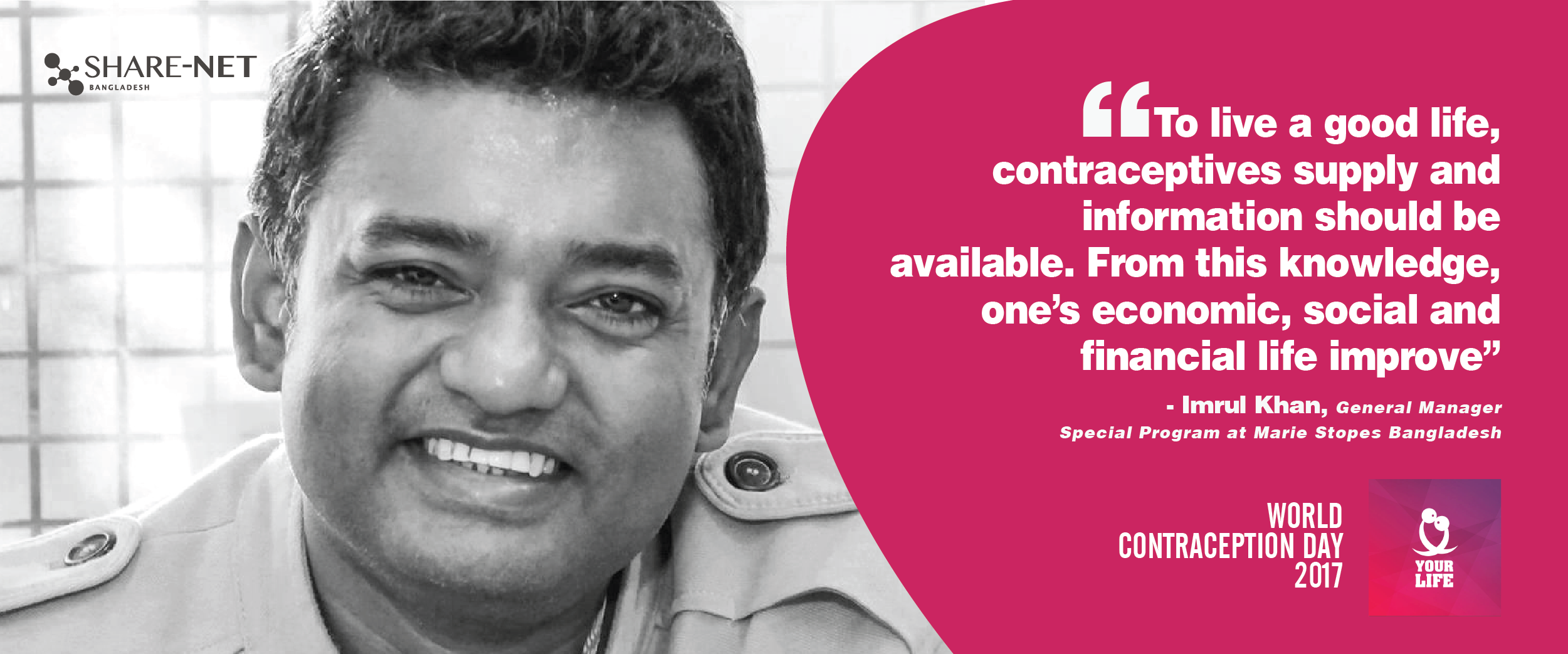Information on contraceptives should be accessible to adolescent
Bangladesh has made impression in achieving MDG 4 and 5 which indicates the family planning and contraceptive use, reduction of the fertility rate and maternal and child mortality. Many adolescent people end up having unintended pregnancy. Though the rate of unintended pregnancy has declined from 33% in 1993 to 29% in 2011, it is on a slow pace.
Share-Net Bangladesh team has an intensive discussion with Imrul Hasan Khan, General Manager, Special Program at Marie Stopes Bangladesh on the reasons and mitigation of adolescent pregnancy, the challenges and importance of the knowledge on contraceptives among youth.
Mostly, newly married couples have unintended pregnancy since they are not eligible to know about contraceptives before marriage. Sex education before marriage is not allowed in our society. For this, the young married couples do not know about the management of sexual life and so, they immediately get pregnant.
Marie Stopes has family planning, clinical delivery service and unsafe MR prevention program in community level among 6 coastal districts across the country and through volunteers, they are trying to reach out to the 16 lakh people. But there are some deep rooted problems lying in it. The contraceptive methods are not accessible to the rural women. The wife has to face the health complications solely by themselves. Their husbands are reluctant to cross the distance to take them to the local health and family welfare centers or buy contraceptives. Since the women are incapable of taking family planning decisions by themselves, they also avoid going to distant health service clinics midst of their busy daily schedule.
Problems also lie in the policy implementation level. Though the family planning structure in District Health level is very strong, sometimes it lacks proper implementation. Because of lack of collaboration and poor monitoring system, the service providers do not go from door to door. The number of Family Welfare Assistant is also poor. Many of them have retired and become religiously restrictive and reluctant.
Switching method is also responsible for increasing unintended pregnancy. Management of fertility puts the women in haphazard situation. Women switch the method because of satisfaction and so, they lose the count of the fertile period and get pregnant. Sometimes they discontinue the pill and later replace it taking lots of pill at a time. They also do not have economic empowerment and decision making capability. So, a woman cannot make decision whether she can be pregnant or not. Hence, they are not able to seek the local health care facilities.
Next Mr. Imrul has talked about the availability of birth control methods. Injections and pills are the most popular among all methods. Among 26,685,961 eligible couples, 38.26% take oral pill and 15.78% take injectable(dgfpmis.org). These are easy to manage and available everywhere. Injections are popular since the women can be safe for three months. IUD is not popular because of lots of stigmas. Also, women do not receive proper counselling on this. From a study by Marie Stopes, it has been found that most women remove IUD within one year. So, they have started following up with the women after the insertion. If the women can continue the insertion for about three months, it can last long. ‘From our rate, IUD is 93% successful but the national rate is far less. There are lots of religious stigmas assigned with it. If there is proper counselling and follow up session, this method will be successful’ says Mr. Imrul.
To aware the adolescent people about reproductive health, Marie Stopes has ASRH (Adolescent Sexual and Reproductive Health) program which engages the rural and urban youth. This includes four projects and each has certain formal structure. With the participation of National Curriculum Board, sex education is introduced in the textbook from biological aspect. After the proper sensitization by the education board, the content is finalized. ‘We are asking the government to increase the content and they also collaborate a lot. The teachers are trained and they are asked to prepare the questions on this. We also provide flipcharts to the teachers to use in the classroom’ affirms Mr. Imrul.
The outcome of this program is reflected on micro and macro level. In the micro level, the adolescent people are concerned about reproductive health. The teacher can teach the students about sexual health after training and the parents can also aware their children and refrain from marrying off the children at early age. In the macro level, the outcome is not visible immediately, but small step in policy implementation after the national level of campaign can create huge impact.
While asked about the access of information on contraceptives among the youth, Mr. Imrul has pointed about the misconceptions in our society. It is believed that sex education will increase the amount of sex among the youth. He has shared his personal experience. ‘Few days ago, we visited Netherlands and there we have found from a baseline study of 2006 -2016 that the rate of having first time sexual experience went through slightly change. The age of having first sexual experience has changed from 17 years to 17.1 years old. Sex education is leveled up in different age limit. The five years old is taught about the body part and gradually the young people know about entire reproductive system. The result proves that sexual education does not impact the sex rate among the youth.’
Mr. Imrul considers that the adolescent people should have access to information about contraceptives. The society also becomes benefitted through this. ‘To live a good life, contraceptives supply and information should be available. From this knowledge, one’s economic, social and financial life improve. Family planning helps to live the life to the fullest’ says he.


